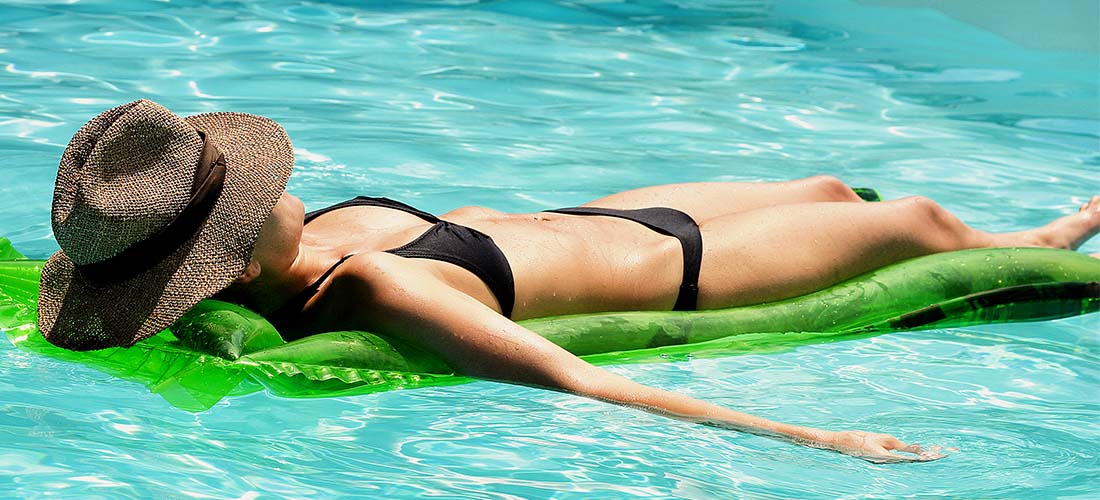Who doesn’t love the warmth of the sun? With summers in full swing, you might have plans to get tanned to get that exotic glow on your skin. Moreover, with artificial tan companies showering their basket full of options, you just can’t wait, or can you?
I don’t need to tell you about your options. You already know them as a tan lover. However, before you run to choose your pick, there are facts that you should know about tanning.
Exposure to UV rays causes premature aging, weakens our immune system and what more, it could also lead to skin cancer. Skin color obtained from the sun or from a tanning booth might be interesting.
Contents
I believe, just to get an exotic complexion, you wouldn’t want to risk your health.
So, here is what you’ll be learning in this post:
- Health effects of every tanning option
- How safe or unsafe it is, and
- Which one should you go for.
The Sunny way
While you are lying under the sun and enjoying its warmth, applying a sunscreen with a minimum SPF of 30 will protect you from harmful UV rays. However, you must note that, SPF only increases the duration of protection. It does not give us the excuse to stay out in the sun for longer periods.
- High exposure to the sun increases your risk of damage to your body. So, along with a sunscreen, compliment yourself with a pair of shades and clothes which can cover up maximum parts of your body.
Most of the sunscreens available in the market offer protection only from UVB rays. UVA rays, the shorter ones, penetrate deeper into your skin and damages its innermost layers increasing the risk of skin cancer. [1]
- Go for a broad spectrum sunscreen which offers protection from both UVA and UVB rays.
Indoor tanning
Artificial tanning has become a hot ticket among the younger lot. They offer you easier and convenient ways to get an even tan without spending hours under the sun. However, before you get thrilled about your tanning options, there are facts you should know.
Just because you are not directly exposed to the sun, doesn’t mean you are safe.
Did you know that spending about 10 minutes within a tan bed equals the 10 minutes we spend under the hot Mediterranean summer sun?[2]
Yes, artificial tanning could be dangerous in ways more than you can imagine!
Tanning beds: Cancer in a Box
Tanning beds use fluorescent phosphor lamps designed to emit artificially created UV rays. As opposed to common belief, they are more harmful as they release intensive rays which are more concentrated and powerful than the usual sun rays.
Almost every single research has concluded that indoor tanning is directly linked to skin cancer. Notably, the International Agency for Research and Cancer (IARC), a working group of WHO, added UV radiation emitting devices like tanning beds and lamps, to the list of most dangerous forms of cancer causing radiation.[3]
So, should I use a sunscreen before lying in the tanning bed?
Well, you can use it, but then it would defeat the very purpose of getting in the bed. Your skin might take longer than usual to get the tanning effect.
If you understand the risks and still choose to tan, then the least you can do is to take these precautions:
- Since you can control the UV emission, keep it to the lowest setting.
- Start slow. Begin by tanning for 5 minutes to see how your skin reacts. Stop immediately if your skin itches or gives you burning sensations.
- Never forget to wear your goggles while tanning.
Tanning Spray booths: Minute to win it
Tanning spray facilities offer booths where you walk in, push a button, stick your hands up in the air while a brown mist sprays your body. This seems to be easier and effective than crawling inside a tanning bed. You are in and out of the booth in a minute!
The good news about tanning sprays is that they do not give you skin cancer.
However, if you are not careful, it can still cause you lung cancer!
These sprays contain a chemical called DHA (Docosahexaenoic acid), a color additive, which browns your skin. Dr. Lynn Goldman, Dean of the George Washington University School of Public Health and Health Services, Washington DC, maintains that if you inhale the spray mist by any chance, it could enter your bloodstream and damage your DNA by causing cell mutation.[4]
Its possible impact is still unknown. However, doctors are concerned that if inhaled, it could lead to tumors, worsen your asthma, and cause lung cancer.
If you take the following steps, you could possibly avoid the risks:
- Wear your goggles just like when you enter your sun bed
- Hold your breath and wear nose clips to avoid inhaling the mist
- Keep your lips sealed while being sprayed. Lips are moist and attract dust and mist. So wear a lip balm.
- Try and make sure that there is ventilation around so that the extra mist diffuses into the air.
Tanning lotions: A safer alternative?
Tanning lotions are comparatively safer than sunbeds and tanning booths. You can self tan by using a tanning lotion, cream, mousse or gel. Just apply them evenly on your skin and you are done!
The good part about these lotions and gels is that you can not inhale them. Just keep them off of your eyes, nose and lips.
However, before you chose any of the alternatives, you need to research on your options properly and be careful as every product and procedure can affect your skin differently depending upon your skin type.
If you have comparatively fairer skin, you should be more careful about your tanning options as your skin is more prone to sunburns and skin damage.
Tanning Pills
The most intriguing options of all, is the popular yet controversial tanning pills.
They use a chemical called canthaxanthin found in plants and animals. It is also a color additive and used in food manufacturing. Pills will give you a sun kissed glow if taken in large amounts. However, they have their own set of side effects.
Since you need to consume these pills in large amounts to get your tan, it might cause severe damage to your eyes. Also, your skin may become dry and itchy. The FDA says that large doses can also lead to liver damage and blood disorders.
So, as you can see, its side effects and elevated health risks does not make it a worthy option.
Skip the tan, eat your veggies!
Don’t you think baking yourself in the sun or getting a fake tan is unaffordable when it comes to your health?
So why not take recourse to a healthy diet? After all that we have discussed, this is an unlikely source. However, a healthy diet rich in carotenoids, can give you that gorgeous glow which mimics a tan.
Carotenoids are compounds that give red, orange, and yellow color to many vegetables. Intake of such vegetables will give your skin warmth and color.
Go for veggies like carrots, tomatoes, winter squash, cantaloupe melons, baked sweet potatoes, broccoli, red leaf lettuce and dark green leafy veggies like turnip greens, beet greens.
Tanning is a natural process for the skin but it damages our skin cells, no matter how you get it – naturally or artificially. So, I would advise not to make tanning a habit. It would be wonderful if you could go the healthy way.
Happy Summers!
Another must read: 8 Steps to Gorgeous Skin
References [1] Neale, R., Williams, G., & Green, A. (2002). Application Patterns Among Participants Randomized to Daily Sunscreen Use in a Skin Cancer Prevention Trial Archives of Dermatology, 138 (10) DOI: 10.1001/archderm.138.10.1319. ^Back to Top^ [2] Scarlett WL (2003). Ultraviolet radiation: sun exposure, tanning beds, and vitamin D levels. What you need to know and how to decrease the risk of skin cancer. The Journal of the American Osteopathic Association, 103 (8), 371-5 PMID: 12956250. ^Back to Top^ [3] Levine, J., Sorace, M., Spencer, J., & Siegel, D. (2005). The indoor UV tanning industry: A review of skin cancer risk, health benefit claims, and regulation Journal of the American Academy of Dermatology, 53 (6), 1038-1044 DOI: 10.1016/j.jaad.2005.07.066. ^Back to Top^ [4] ROGERS, C. (2005). Spray-on tanning Aesthetic Surgery Journal, 25 (4), 413-415 DOI: 10.1016/j.asj.2005.04.003. ^Back to Top^







Comments are off this post!